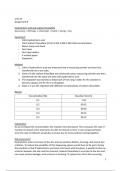Unit 18
Assignment B
Hydrochloric acid and sodium thiosulfate
Na2S2O3(s) + 2HCl(aq) → 2NaCl(aq) + H2O(l) + SO2(g) + S(s)
Equipment
- 10ml Hydrochloric acid
- 10ml Sodium thiosulfate (0.1M, 0.2M, 0.3M 0.4M 0.5M concentraMon)
- Retort clamp and stand
- Test tubes
- Test tube holders
- X marked paper
- Stopwatch
Method
1. 10ml of hydrochloric acid was measured into a measuring cylinder and was then
transferred into a test tube.
2. 10ml of 0.1M sodium thiosulfate was measured using a measuring cylinder was then
transferred into the same test tube with hydrochloric acid.
3. The stopwatch was started, to keep track of how long it takes for the soluMon to
become opaque and for the x to disappear.
4. Steps 1-3 was the repeated with different concentraMons of sodium thiosulfate.
Results
ConcentraMon (M) ReacMon Mme (S)
0.1 1:10
0.2 00:35
0.3 00:20
0.4 00:15
0.5 00:12
ExplanaMon
As we increased the concentraMon, the reacMon Mme decreased. This is because the rate of
reacMon increased, more molecules are able to interact to form a new compound faster
since the rate of collisions would also increase due to more parMcles coming together.
Risk assessment
Hydrochloric acid is corrosive to the skin and can produce blisters, bruising, and severe skin
irritaMon. To reduce the possibility of this happening, gloves would have to be worn during
the pracMcal so that if hydrochloric acid came into touch with the glove, it would funcMon as
a barrier between the skin and the chemical. Sodium thiosulfate is corrosive to the skin and
can cause serious damage, such as burns or bruising. To reduce the risk of this occurring,
1
, sodium thiosulfate would have to be handled in a safe manor, gloves would have to be worn
throughout the pracMcal so that if the chemical was to mistakenly get onto the skin the
gloves would act as a barrier. Sodium thiosulfate is also harmful to the eyes, if it was to enter
the eyes it would cause irritaMon to the eye or further damage. To reduce the risk of this
occurring, safety goggles would have to be worn throughout the pracMcal so that if sodium
thiosulfate was to splash, it would not be able to meet the eye and cause any
damage.
Hydrochloric acid with magnesium ribbon
Mg(s) + 2 HCl(aq) --> MgCl2(aq) + H2(g)
Equipment
- Hydrochloric acid (1.0M)
- 0.3g Magnesium ribbon (5cm)
- 0.3g Powdered magnesium ribbon
- Test tubes
- Test tube holder
- Measuring cylinder
- Stopwatch
Method
1. 15ml of hydrochloric acid was measured using a measuring cylinder and was then
transferred into a test tube.
2. 5cm of magnesium ribbon was then added to the same test tube containing
hydrochloric acid, the stopwatch was then started.
3. The rate of reacMon was then observed and the Mme was recorded.
4. Steps 1-3 was then repeated with powdered magnesium ribbon.
Results
Par$cle size of magnesium (g) Reac$on $me (S)
0.3g Magnesium ribbon 1:23
0.3g Powdered magnesium 0:57
ExplanaMon
As the parMcle size increased, it took a shorter Mme to react with hydrochloric acid this is
due to surface area. The more surface area that is available, more parMcles would be
exposed to the reactant and would increase the chance of parMcles colliding, this leads to
more collisions per second and causes the rate of reacMon to increase, in comparison with
magnesium ribbon which took a longer Mme to react with hydrochloric acid.
Risk assessment
Hydrochloric acid is corrosive to the skin and eyes, this could cause severe burns to the skin
or permanent damage to the eye. If this was to be inhaled this could cause irritaMon to the
throat or nose, if hydrochloric acid was to be handled in high concentraMons it would need
to be handled in a fume cupboard to reduce the risk of inhalaMon. To reduce the risk of
2





